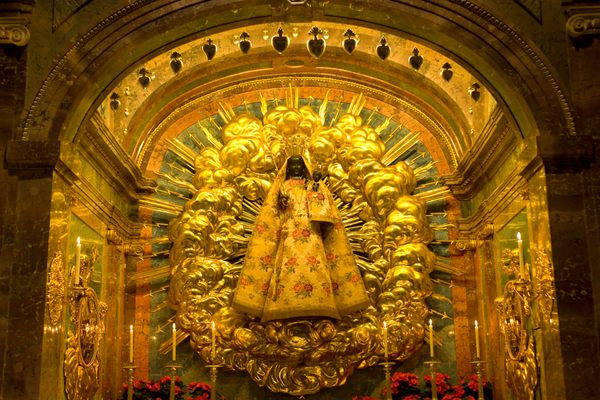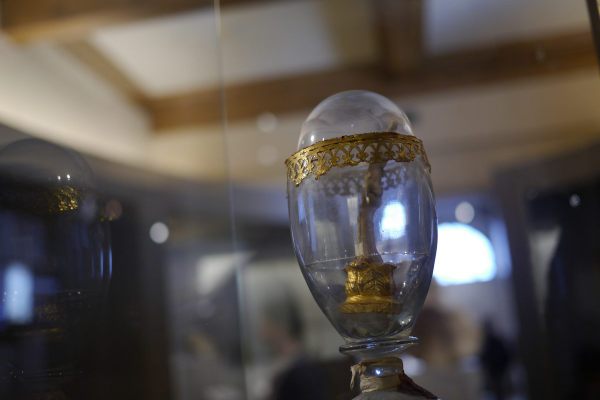The (Really) Great Gig in the Sky
The altar at Il Gesu (photo by Elizabeth Harper)
When someone told me I had to see the light show at Il Gesu, I thought they were out of their mind. A light show is something you see after hours at a planetarium with a bunch of stoned teenagers, not at the mother church of the Jesuit order in Rome. And yet every day at 5:30 a small crowd gathers to have their minds blown, albeit in a way that has nothing to do with Pink Floyd.
I recommend going on a rainy, overcast day like I did. When I walked in, I found the church barely lit. A pale yellow gloom dulled the gilded columns and hung like a cloud over the massive nave. In the right transept, the mummified arm of St. Francis Xavier went practically unnoticed. Everyone was focused on the altar in the left transept dedicated to the founder of the Jesuit order, St. Ignatius Loyola.
St. Francis Xavier’s mummified arm (photo by Elizabeth Harper)
At exactly 5:30, spotlights hit the gold altar and a recorded version of Kyrie blared through the speakers. The light reflected off all of the gold was nearly blinding after I had adjusted to the late afternoon gloom.
This was the Counter-Reformation at its finest. When Protestant reformers stripped away what they saw as excess and idolatry, the Catholic Church doubled down on art and ritual. They employed the great artists, architects, and theatrical designers of Rome to translate religious concepts into stunning Baroque visuals like this one.
Over the course of the show, an Italian narrator took us through the life of St. Ignatius, although Andrea Pozzo, the designer of the transept (along with one hundred or so assistants) had already done the real work back in 1695. Thanks to him, you didn’t have to understand a word to comprehend the importance and piety of St. Ignatius. In the painting above the altar, Ignatius was shown kneeling before Jesus in heaven. Below the altar, his large bronze casket glowed in an amber light.
Altar painting (photo by Elizabeth Harper)
St. Ignatius’ casket (photo by Elizabeth Harper)
As the music segued from Kyrie to Gloria, the narrator explained that the Jesuits were missionaries who specialized in converting people in particularly dangerous and far-away places. This is how they earned the nickname “God’s marines.” However, the visuals revealed a more complete truth, at least to modern viewers. In the bottom part of the painting over the altar, an angel tended to four allegorical figures representing the four corners of the Earth: Asia, the Americas, Africa, and Europe. I bet you can guess which of those allegorical figures looked most like the angel.
Then an allegorical figure of Religion lit up. She brandished a cross like a vampire hunter and appeared to be shoving two poor guys named Heresy off the marble podium with her foot (Heresy happened to look an awful lot like Protestant reformers Martin Luther and Jan Huss).
Religion shoving Heresy off the podium (photo by Elizabeth Harper)
It was then I realized sculptures of Jesuits always seem to be stepping on (allegorical) people. Just look at the façade of Il Gesu over the side doors, and you can see St. Ignatius stepping on Heresy and St. Francis Xavier stepping on Paganism. Or look at this statue of St. Ignatius from Sant’Ignazio down the street (picture below). Perhaps it’s fitting: though Jesuits were known for learning the language and customs of the people they converted, they also did their share of trampling anything in their way—including indigenous culture.
St. Ignatius stomping on Heresy (photo by Elizabeth Harper)
These uncomfortable truths were completely upstaged by the final act in the show. As the music swelled and the lights dimmed, a Baroque piece of stage machinery designed by Pozzo lowered the painting into a hidden slot beneath the altar. When the spotlights turned back on, they revealed a gleaming, larger-than-life silver statue of St. Ignatius where the painting used to be. (Unfortunately the statue currently on display is a silver-leaf replica, since the solid-silver original was melted down to pay off Napoleon.) The gold-and-lapis niche combined with the statue’s bejeweled chasuble to complete the altar in a way the painting didn’t quite achieve.
Painting lowering into a hidden slot beneath the altar (photo by Elizabeth Harper)
Statue of St. Ignatius (photo by Elizabeth Harper)
I only had a moment to take the statue in when the ceiling overhead lit up and showed us St. Ignatius ascending into heaven in forced perspective. The fresco was painted on stucco and wood applied over the ceiling coffers, which gave the impression of St. Ignatius busting straight through. Then the entire ceiling illuminated, filling the space with light and letting the gold leaf on every surface shine. The effect was overwhelmingly beautiful and about as subtle as the Kool-Aid Man entering though the wall.
Ceiling fresco (photo by Elizabeth Harper)
But that’s the Counter-Reformation for you. Although Andrea Pozzo could have never imagined the addition of LED lighting to his masterful trick transept, I think he’d be pleased with the effect. It beats the planetarium anyway.
Elizabeth Harper writes about saint relics at All the Saints You Should Know. You can also find more on the remains of the holy departed at the new All the Saints You Should Know Facebook page.







Follow us on Twitter to get the latest on the world's hidden wonders.
Like us on Facebook to get the latest on the world's hidden wonders.
Follow us on Twitter Like us on Facebook